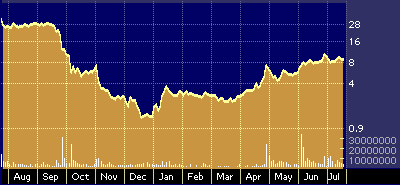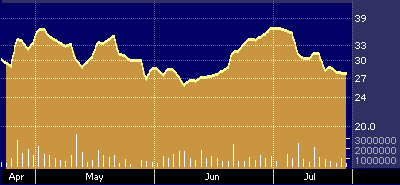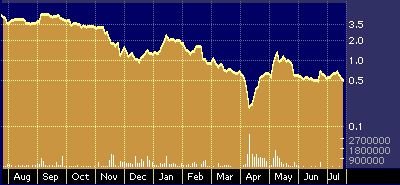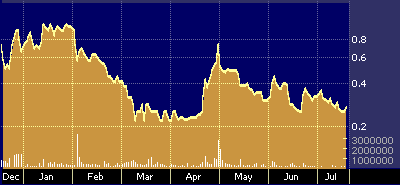
Will the Holidays Be Kind to E-Tailers?
Will the Holidays Be Kind to E-Tailers?
By Hal Plotkin
Silicon Valley Correspondent
Some analysts say Amazon.com Inc.’s {AMZN} recovering stock will go considerably higher before the holidays are over, but others see even bigger opportunities elsewhere in the hard-pressed but seasonally hot e-tailing sector.
Investors anticipating the traditional holiday run-up have already pushed leading online retailer Amazon.com’s stock up more than 35 percent over the past month.

Amazon on-month stock performance chart
Tom Wyman, an analyst at J. P. Morgan Securities, sees Amazon.com’s stock going a lot higher before the end of the year. On Wednesday, he reiterated his “buy” rating on the stock, which he says should hit 60 a share by January.
Wyman cites historical patterns to justify his confidence in a continuing strong pre-holiday move for Amazon.com. He notes that the stock was up 108 percent from August through December 1997, rose 412 percent in 1998 during the same period, and shot up fully 90 percent in the second half of 1999.
Increased media attention about online shopping over the holidays will once again fan the flames of investor interest in the leading online retailer this year, Wyman predicts.
“We see Amazon.com as a stocking stuffer at today’s prices,” Wyman adds.
Several other analysts also see more upside for Amazon.com’s stock. But like Wyman, they quickly add that it isn’t just a holiday story.
“We were pounding the table hard on Amazon when it was at $30,” says Timothy Fogarty, an analyst at Thomas Weisel Partners in San Francisco.
Fogarty says that he thinks the stock still has upside potential, though probably not as much as it had before the pre-pre holiday shopping spree began. He has a “buy” rating on Amazon.com’s stock, his firm’s second-highest rating, along with a 12-month price target of 65.
“Amazon is still a very volatile stock heading into Christmas,” Fogarty notes. “But I think the take-away after Christmas will be that Amazon has solidified its position as the online leader.”
Pro-Amazon.com analysts say they base their confidence on the company’s strong brand name and the fact that it has already done the heavy lifting of building out the expensive physical infrastructure needed to support additional fast growth.
Amazon.com’s 10 product-fulfillment centers, basically high-tech pick-and-pack warehouses, currently operate at just about one-third their capacity, Wyman says.
“They’ve already built their infrastructure,” Wyman adds. “All they have to do now is scale them up, and that’s what’s happening.”
The progress, Wyman says, puts Amazon.com on track to achieve overall profitability around the fourth quarter of 2001.
Fogarty says Amazon.com’s push beyond its traditional book, music and video markets into newer summertime goods, such as auto purchases and vacation travel, positions the company to keep the revenue rolling in after the holiday season. Strong year-round sales are a critical ingredient in the company’s business plan, he notes.
But Fogarty sees at least one better buy in the online retailing sector right now: priceline.com Inc. {PCLN}.
Although it isn’t a holiday stock, per se, Fogarty says priceline.com could be the next beneficiary of the renewed investor interest in dot-com retailers that is represented by Amazon.com’s recently resurgent stock.
“Priceline is a real value proposition,” Fogarty says. “They sold 1.3 million tickets in the second quarter and took 3 percent of the leisure travel market. They are also demonstrating applications across many business categories that are being very widely adopted. Say what you will about it, but priceline is creating a new way of buying and selling products that in my view will become more mainstream.”

Priceline.com 52-week stock performance chart
Fogarty has a “strong-buy” rating on priceline.com’s stock, along with an $85 12-month price target. He says the company will soon have something most other online retailers, including Amazon.com, can only dream about: black ink on the bottom line.
“I expect to see priceline breaking even over the current quarter and profitable for the full 2001 year,” Fogarty says. “I think that’s something investors will focus on as the strength in the leaders such as Amazon carries over to priceline.”
Ryan Alexander, an analyst at Wit SoundView in New York, also tabs priceline.com as his top e-tail stock pick. Like Fogarty, he forecasts breakeven results for the company’s third quarter this year, followed by profitability.
“Investors have been looking for online companies to execute on a profitable business model,” he says. “Priceline hasn’t witnessed the [price] appreciation that others such as Amazon and Homestore.com Inc. {HOMS} have yet, but the company should be appealing to a broader audience soon.”

Homestore.com 3-month stock performance chart
Alexander has a “strong buy” rating on piceline.com’s stock, along with a $55 12-month price target.
Daniel Ries, an analyst at C.E. Unterberg Towbin in New York, says investors looking to cash in on the pre-holiday e-tail run-up might find their best returns by scooping up second-tier e-tailer Cyberian Outpost Inc.’s {COOL} stock at its currently depressed price.

Cyberian Outpost 52-week stock performance chart
Kent, Conn.-based Cyberian Outpost, which runs the Outpost Web site, started out by mostly selling electronic goods online, though the company has diversified its product offerings in recent months. The company emphasizes service, rather than discount pricing, for example, by shipping goods overnight without an additional charge and by operating a 24-hour customer-service call center.
On June 20, Cyberian Outpost posted net sales for its first quarter of fiscal 2001, ended May 31, of $64.8 million, which was double the $32.7 million it rang up during the same quarter last year. Losses came in at 26 cents a share during the company’s first quarter, as compared with a loss of 38 cents a share for the same quarter last year. The results represented a loss that was 4 cents narrower than had been forecast by the consensus analyst estimate compiled by First Call Corp.
“Cyberian Outpost has a much-cheaper valuation [compared with its peers] and has much higher gross margins,” says Ries, who has a “strong buy” rating on the stock, along with a $20 12-month price target.
“I realize my price target seems a little far-fetched at this time,” Ries says. “But I’m really looking for the results to come in for the August quarter, which will report in about three weeks.”
Ries says that unlike competitor BUY.COM Inc. {BUYX}, which originally emphasized cut-rate pricing to build its customer base, Cyberian Outpost focused first on customers willing to pay a little more for better service.

Buy.com 52-week stock performance chart
BUY.COM, by contrast, risks losing many of its price-sensitive customers, Ries says, now that the company is moving past the lowest-price-around strategy it first employed to attract online shoppers.
“Cyberian Outpost looks like one of the few that can grow its revenue base,” Ries says. “Focusing on service rather than just price looks like the better business model.”
Jeetil Patel, an analyst at Deutsche Banc Alex. Brown in San Francisco, sounds a much less sanguine note.
Patel says investors could easily get burned if they get too caught up in the pre-holiday e-tailing hype. Buying stocks because you think they will do well over the next 30 or 60 days is a very risky business, he says, since investors can’t be certain about when the short-term bull run will conclude. The last investors out of the pool could take a pretty big bath, he says.
“My position is that it probably makes sense to underweight the whole [e-tail] sector right now,” Patel says. “A few good days does not indicate a trend. You have to remember that it was only a few months ago that investors were looking for profitability and big cash reserves. That’s still what investors should be thinking about. They shouldn’t be looking for a stock for the next 30 days.”
Patel has a lukewarm “market perform” rating on Amazon.com, for example, which is based, he says, on his long-term outlook for the company, rather than on hopes it will be the beneficiary of exaggerated media attention over the holidays.
“The much smarter thing to do is to use the longer-term horizon as the first test and then consider how a stock might do over the near term,” Patel adds.
Overall online worldwide holiday retail sales are expected to reach $19.5 billion this year, representing a staggering 85 percent increase over last year, according to a new study by the Gartner Group, based in San Jose, Calif.
But that surge in sales won’t lift all online e-tail boats, warns Robert Labatt, principal analyst for Gartner’s e-Business Services Group.
“The jury is still out on whether Amazon can get their volume up to a level that sustains their costs,” Labatt says. “As Amazon continues to expand into other areas, they also risk diluting their brand so that people stop thinking of them first for books, music or video.”
In addition, several of the analysts say that next Christmas, when increased numbers of big-name, traditional brick-and-mortar stores finally get their own online operations fully up and running, will be the decisive moment for the pure-play online retailers.
“It’s not this Christmas but next Christmas they really have to worry about,” Wyman says. “They’re going to have to look over their shoulder at established companies, such as Circuit City Stores Inc. {CC}, Good Guys Inc. {GGUY} and Best Buy Co. Inc. {BBY}. They’re all going to be coming right at them.”


